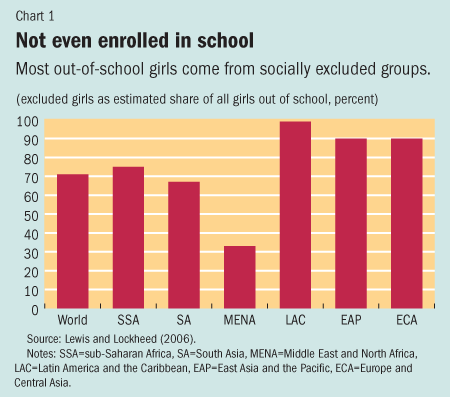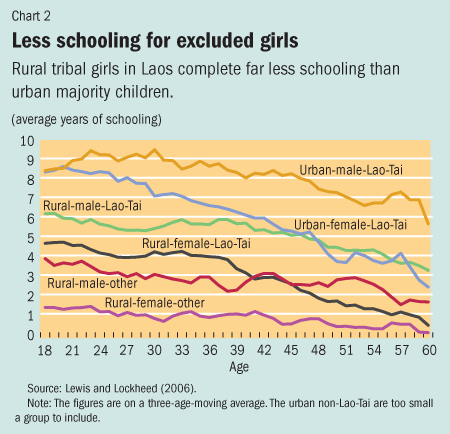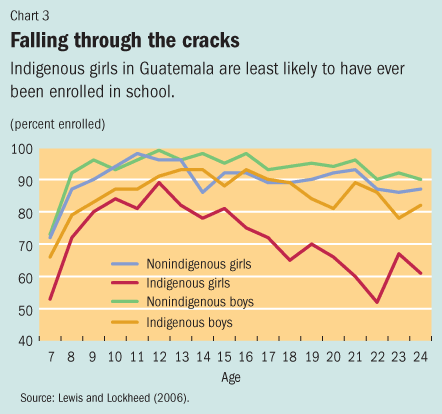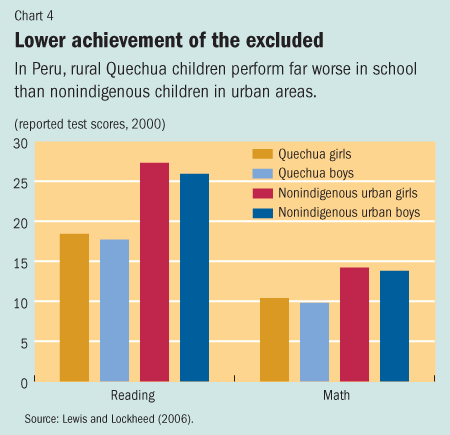Maureen A. Lewis and Marlaine E. Lockheed
New ways are needed to educate "excluded girls" in developing countries
Since 1960, primary school enrollment rates in the developing world have risen steeply for boys and girls, with girls' participation converging with that of boys in most countries. Yet UNESCO (2006) recently estimated that 43 million school-age girls are not enrolled in school, many more complete fewer than six years of schooling, and a gap between boys and girls remains in some countries. This gap is due overwhelmingly to the lag in schooling of socially excluded groups, often minority groups that are on the margins of society (see box and table) and in which girls are at a distinct disadvantage relative to boys. Indeed, we estimate that approximately 70 percent of these out-of-school girls come from such groups.
Where are these out-of-school girls? By far the greatest number are in sub-Saharan Africa (47 percent) and South Asia (25 percent), followed by East Asia and the Pacific (11 percent); the Middle East and North Africa (9 percent); and Latin America and the Caribbean, Eastern Europe and Central Asia, and North America and Western Europe (all close to 3 percent). However, the Latin American and Caribbean region scores highest when the focus is on the percentage of out-of-school girls coming from excluded groups (see Chart 1).

The educational consequences for the socially excluded—girls in particular—are real. They range from teachers ignoring students in class to the destruction of schools and violence against teachers and communities. Compounding the problem, socially excluded groups are often less likely to send their daughters to school and more likely to allow their daughters than their sons to drop out early.
Over the past decade, much has been learned about how to reach poor children and those from excluded groups. Most of this experience is from developed and middle-income developing countries. Programs have been designed that raise enrollments, sustain attendance, and equalize learning outcomes of excluded children. Similarly, much is known about how to reach girls. But relatively little is known about how to reach excluded girls specifically. This article highlights some of the lessons from our recent Center for Global Development study, which looks at why girls from socially excluded groups are not in school and what can be done about it.
The extent of the problem
To begin with, it is helpful to think of countries as highly homogeneous (like South Korea and Tunisia, which have a single ethnic group with a common language and a shared cultural heritage) or heterogeneous—with multiple ethnic groups that speak different languages and often have distinct cultures. In the latter group, communities that are "different" from the mainstream society and economy tend to become excluded, and it is the parents in these communities who are likely to keep their children out of school, in contrast to parents in majority communities, who are increasingly sending both boys and girls to school.
|
Who's excluded and why? Socially excluded groups are population subgroups that are prevented by discrimination and indifference in their own countries from receiving the social rights and protection meant for all citizens. These groups—ethnic minorities, isolated clans, and groups in which the majority language is not predominant—are marginalized for various reasons:
Source: Meerman (2005). |
Why do minority parents keep children at home? The reasons are complex and many. They include a general resistance to change; a desire to retain a separate ethnic identity; a lack of interest in what schools offer; a worry about discrimination and mistreatment (children might be beaten or simply sidelined); a need for child labor and apprenticeships within the family; the direct costs of fees, books, and uniforms; limited employment opportunities upon graduation; low economic returns to those who have attended school; a lack of accessible and acceptable schools; and concerns for safety (especially for adolescent girls). And minority communities are more likely to educate boys than girls because boys have better labor market opportunities, and girls in many societies are "married away" and join their husband's family. Moreover, when excluded children do attend school, they are more likely to drop out and less likely to complete primary school.
|
Who they
are
Source: Lewis and Lockheed (2006). |
Although concrete data are available for relatively few countries, the following examples give a sense of the extent and degree of the problem of girls' exclusion.
- In India, 37 percent of girls aged 7–14 belonging to the lowest castes or tribes do not attend school, compared with 26 percent of majority girls of the same age. School attendance for tribal girls is 9 percentage points below that of tribal boys.
- In Laos, Hill Tribe girls from rural communities complete fewer than two years of school, whereas majority Lao-Tai girls from urban communities complete eight years (see Chart 2).
- In Guatemala, indigenous girls are the least likely to have ever enrolled in primary school (see Chart 3), and only 26 percent of indigenous non-Spanish-speaking girls complete primary school, compared with 62 percent of Spanish-speaking girls.
- In the Slovak Republic, only 9 percent of Roma girls compared with 54 percent of Slovak girls attend secondary school.


But all available evidence suggests that, once in school, excluded girls perform as well as, or even better than, excluded boys at the primary level (although the achievement levels of excluded children as a whole lag behind those of majority children). This difference between girls' and boys' performance holds true in industrial countries, where girls outpace boys in schooling completion among the majority population. It also holds true among minority groups—the Maori in New Zealand and African-Americans and indigenous groups in the United States—once concerns about language, culture, and treatment in schools have been addressed and access to quality schools has improved. Most studies in developing and transition countries do not disaggregate achievement results, but some country studies yield encouraging findings on girls' achievement:
- In Peru, the fifth-grade reading and mathematics scores of rural Quechua girls were no different from those of rural Quechua boys, although the performance of Quechua children was substantially lower than that of nonindigenous urban children (see Chart 4).
- In Ecuador, indigenous girls scored higher than indigenous boys on fifth-grade mathematics tests, with scores nearly as high as those of nonindigenous children.

Reaching and teaching excluded girls
We infer from what we have learned about reaching poor and excluded children that getting and keeping excluded girls in school requires different approaches and entails higher costs. Cultural variations, linguistic differences, and girls' special needs (for example, safety and hygiene) drive up costs because they require new methods tailored to each group. Investment on two fronts is essential for enrolling and retaining excluded children in general, and girls in particular.
First, many countries still lack good-quality educational opportunities for all students. Thus, the first line of attack is to improve the quality of schooling through three key actions:
Make education policies more fair. Policies that appear fair may be subtly biased against girls from excluded groups. For example, policies requiring use of a majority language in school may be particularly disadvantageous to girls from excluded groups because they often have less exposure than boys to the majority language. Similarly, policies that require either single-sex schools or coeducation may limit girls' opportunities, when, as a result of such policies, only schools for boys are established, as in some areas of Pakistan, or parents restrict older girls' attendance in coeducational schools.
Expand schooling options. Parents' concern for their daughters' safety may mean that nearby community schools and informal alternative schools can attract and retain girls from excluded groups more easily than formal schools located at a distance. For example, in Rajasthan, India, community schools that employed paraprofessional teachers, allowed the community to select and supervise teachers, and hired part-time workers to escort girls from excluded groups to school had higher enrollment, attendance, and test scores than public schools. Preschools can help excluded children transition more easily to formal schools. In Brazil, Turkey, Bolivia, and India, preschool programs involving both mothers and children from excluded groups have reduced primary school dropout rates and boosted achievement. Compensatory programs also help. Brazil, India, and Spain have offered targeted, compensatory in-school or after-school programs to help disadvantaged students stay in school, raising their achievement. In India, where young women were hired to tutor children who were lagging behind, the largest achievement gains were recorded for the most economically disadvantaged children. Radio, television, and computers can also expand opportunities for girls, particularly those kept home after primary school.
Improve the physical environment and instructional materials. Girls are less likely than boys to enroll in, and more likely to drop out of, schools that are in poor physical condition (for example, with leaky roofs), whose teachers are often absent, and with inadequate materials. And those who stay in school under these circumstances—especially if only the majority language is taught—tend to perform more poorly. In fact, studies show that school quality matters more for excluded girls than for boys and children from mainstream families because minority parents often have higher standards for the state of the school and the quality—and often gender—of the teachers. What can be done? One solution lies in offering bilingual education. Other solutions encompass targeting additional resources to schools where average performance is low, repairing school buildings, strengthening the curriculum, and hiring knowledgeable teachers, something that cannot be taken for granted.
The second line of attack is to create incentives for households to send girls to school. Evidence on what incentives might work is less clear and needs more focused evaluation.
Offer conditional cash transfers. Such transfers help households defray some education costs, tying assistance payments to desirable behaviors. They are often challenging to administer but do motivate families to send children to school. Programs in Bangladesh, Ecuador, and Mexico, among others, have been successful, although their specific impact on excluded groups has not been assessed. A conditional cash transfer program in Ecuador boosted school enrollment overall by 3.7 percentage points but did not benefit girls or minority students in a significant way.
Offer scholarships and stipends for girls. Secondary school
scholarship programs offer girls financing and encouragement to stay in school
and compensate families for the direct and indirect costs of education. They
have been highly effective in several countries, notably Bangladesh, where
scholarships for girls increased their enrollment to twice the national average
for females. Stipend programs also compensate parents for the cost of schooling
but are tied to such school inputs as uniforms, books, materials, and
transportation. Even the opportunity to earn a scholarship has been found to
boost student achievement.
Introduce school feeding programs. Various feeding programs are associated with higher enrollment and attendance. In Kenya, free meals raised attendance in program schools 30 percent relative to schools without free meals, and test scores rose substantially. But rigorous evaluations found that the feeding programs benefited boys rather than girls and did little to reduce the gender gap.
How to make it happen
Practical actions to promote education for excluded girls entail tailoring programs that appeal to parents and students, drawing on the kinds of successful efforts discussed above. These are generally expensive alternatives but have been shown to be necessary to bring excluded children, particularly girls, into school and ensure that they remain and graduate. The United States' Head Start program is one such example, and middle-income countries like Chile, Malaysia, and Mexico have pioneered similar programs.
But lower-income countries cannot afford the extra efforts required to reach excluded groups and the out-of-school girls in those communities. For them, external support will be needed. First, bilateral, multilateral, and private donors should direct their support to programs that have demonstrated positive effects for excluded girls. A trust fund could be established to provide the financial basis for expanding successful efforts in reaching, retaining, and teaching excluded girls. Second, a girls' education evaluation fund could help expand the knowledge base about what works, particularly in Africa, where evidence is slim and more than 40 percent of excluded girls reside. Finally, the UNESCO Institute for Statistics should report school participation and achievement data disaggregated by gender and exclusion, which will be essential for monitoring improvements and determining what approaches are most effective.
|
References: Lewis, Maureen A., and Marlaine E. Lockheed, 2006, Inexcusable Absence (Washington: Center for Global Development); see http://www.cgdev.org/content/publications/detail/11898 Meerman, Jacob, 2005, "Oppressed People: Economic Mobility of the Socially Excluded," Journal of Socioeconomics, Vol. 34 (August), pp. 542–67. UNESCO, 2006, 2007 Global Monitoring Report: Strong Foundations: Early Childhood Education (Paris). |
| Maureen A. Lewis is Acting Chief Economist for Human Development at the World Bank, and Marlaine E. Lockheed is a Visiting Fellow at the Center for Global Development and formerly Education Sector Manager at the World Bank. This article draws largely from their book Inexcusable Absence. |